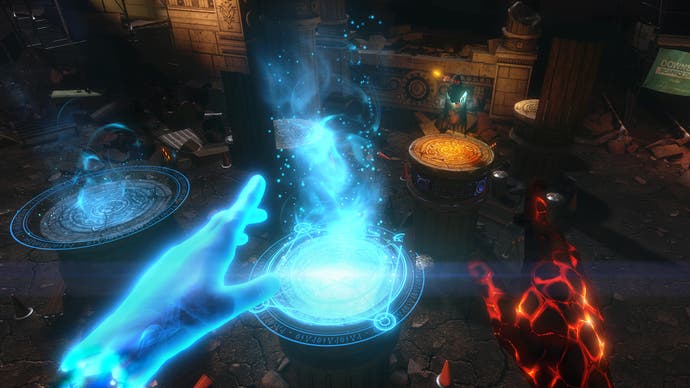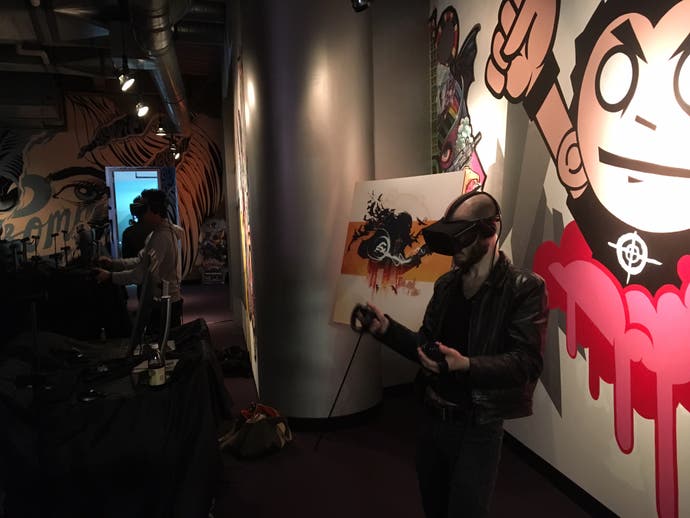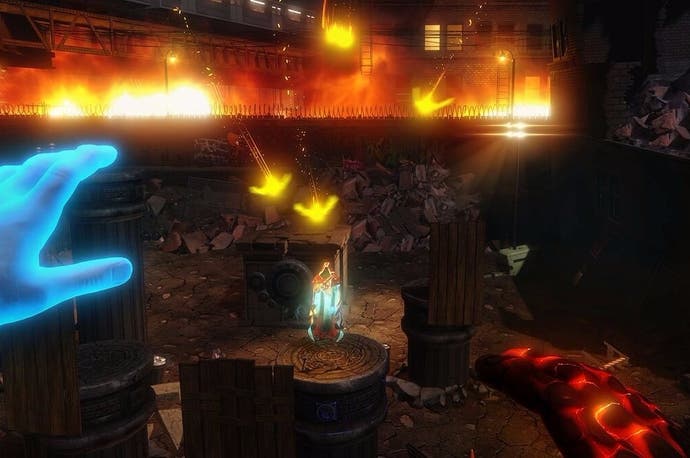Insomniac's The Unspoken re-invents fighting games for VR
Great balls of fire.
Insomniac Games is known more for polish than originality. After 11 Ratchet & Clank titles, a few first-person shooters, and Sunset Overdrive's open-world mayhem, Insomniac's got a reputation as a commendable, workmanlike studio, but not a particularly daring one. That's all changing with the Burbank-based studio jumping head-first into the realm of VR with three Oculus titles in development, and one of these in particular stands out as being completely unlike anything else on the market.
The Oculus Rift-exclusive The Unspoken is a brand new type of PvP fighting game. Rather than opt for the combo-based fisticuffs of Street Fighter or the tactical turn-based nature of Hearthstone or Clash of Heroes, The Unspoken is more like baseball, laser tag and Tron blended together. Having had a few goes with it at Insomniac's Burbank office, I can say that it's one of the strongest arguments I've seen for the potential of VR multiplayer.
It may not come across well in a trailer, however, as the true pleasure of playing The Unspoken comes from the cathartic contortions you wring yourself into while playing it. Based on the following video, you get that its story has something to do with a hidden realm of duelling sorcerers in Chicago (why not?) and that you shoot your opponents with fireballs and magic spells.
What the trailer doesn't properly convey is that you don't "shoot" your enemies with fireballs, but rather you throw fireballs at them. Indeed The Unspoken uses Oculus Touch motion-controls, and this most basic of actions - which you learn within the first few seconds of the game's tutorial - is immediately gratifying in a way completely lost when simply viewed on a screen.
There's something inherently thrilling about squeezing a trigger to watch a crackling, whirling plume of flame erupt in your palm and grow in ferocity the longer you wield it. Then, with an effortless toss, you send it hurtling towards your opponent. The Unspoken may be bound by digital code manifesting itself in these machines, but this one simple pyromantic fantasy feels like magic.
Your left hand is equally empowering, as it wields a shield that you can positionally track around your persons. Pointing it at the right angle and height is important as it not only prevents damage, but can deflect certain attacks back at your opponent. It temporarily deteriorates when absorbing sustained attacks though, so you can't rely on it too much as a crutch.
The other way to avoid enemy attacks is to move out of the way. In a smart decision to both add tactical depth and prevent motion sickness, players don't have free range of movement. Instead, each arena is comprised of a handful of pillars you stand on and you use the analogue stick to teleport from one pedestal to another. (Those who played Dishonored will find themselves at home with this "blink" mechanic.) Some pillars have destructible cover, others offer higher ground, and you'll often want to warp around to grab respawning magic pellets for spellcasting.

Spells offer more powerful attacks or erect additional defensive barriers, but they cost mana points to use and require dedicating a few tense seconds of free time to cast via a variety of mini-games. A powerful lighting javelin can be thrown, but you need to smack a few targets on an anvil in a Whack-A-Mole fashion to forge it; an exploding paper airplane offers a powerful homing attack, but you needs to press a few seemingly holographic prompts on a sheet of paper in front of you to fold the darn thing; and a large magic barrier can provide protection so long as you take the time to trace a rectangular pattern.
We quickly discover strategies and counter strategies to this peculiar combat system. A fellow player realises he can ready his spells while behind cover then warp somewhere with a better vantage point to unload them. Another figures out that launching a murder of flaming crows may not do a ton of damage, but these fiery beasts home in on their target. Others discover that destroying three mysterious floating grey runes grants you the remnants of a golem that can be assembled to smash your opponent's side of the court before obliterating them in one fell swoop. Careful though, as it's easy to take damage while constructing this colossus.
One easy to miss but completely brilliant detail about The Unspoken is how its spell-selection menu is manifested. Insomniac found that hitting a button to bring up a menu not only felt obtrusive, but distracted players unfamiliar with the controller's button layouts. "That was our traditional design sense creeping in," says Insomniac CEO Ted Price. Telling people to hit the X button isn't useful when looking down only shows you glowing wizard hands. Sure, you could take the VR headset off, but that's disruptive.
Instead, Insomniac realised that flipping your left palm upward to present a floating menu of spells just felt right. Grabbing your selected spell with your right hand also seems sensible. This is one of those weird choices where seemingly simple stuff - like control scheme prompts - needs to be completely reconsidered in this VR context. "This game forced us to rethink our assumptions about design," Price says.

Insomniac had actually been contemplating making The Unspoken for several years, but it wasn't until the studio saw Oculus' Toy Box demo at E3 last year that the developer felt it was possible to manifest in any satisfying way.
"It's something that we've wanted to explore for a really long time at Insomniac," says creative director Chad Dezern, who heads up development at Insomniac's North Carolina studio. "It's one of those ideas that's had really remarkable staying power; the type of thing that we talk about between projects and really think about the possibilities of it and get excited every time. Then at E3 last year we saw the Touch controller for the first time and it was like getting struck by a bolt of lightning. We knew that this premise that we'd been thinking about and those controllers were made to be together."
It feels mostly spot-on. There's a still a few kinks to work out - the prompt for summoning the magic barrier is a little ropey at the moment, and it's a little unclear which pillars you can stand on as, tennis-like, each player is quarantined to their half of the arena - but by and large the sensation of hurling magic spells, blocking incoming attacks, and warping about feels like the sort of elegant virtual sport VR was made for.










